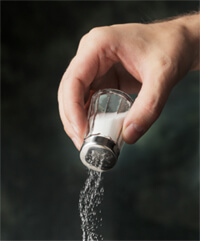Cutting Sodium
This information was reviewed and approved by Andrew M. Freeman, MD, FACC, FACP (3/31/2014).
 Clinical Trials
Clinical Trials
For more than 100 years, National Jewish Health has been committed to finding new treatments and cures for diseases. Search our clinical trials.

 The American Heart Association recommends 1500 mg of sodium a day — this is less than a rounded teaspoon (1725 mg). Keep in mind that salt is not only what comes out of the shaker, but also what goes into the food during processing and manufacture. For instance, although you may not add salt to canned or ready-made soup, usually one serving has enough salt for the entire day in just one small bowl.
The American Heart Association recommends 1500 mg of sodium a day — this is less than a rounded teaspoon (1725 mg). Keep in mind that salt is not only what comes out of the shaker, but also what goes into the food during processing and manufacture. For instance, although you may not add salt to canned or ready-made soup, usually one serving has enough salt for the entire day in just one small bowl.